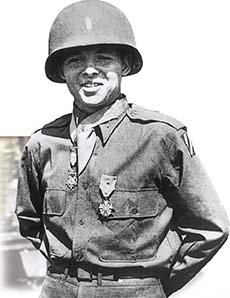SECTION 3: Victory in Europe and the Pacific

Lieutenant Audie Murphy ►

Medal of Honor ►
WITNESS HISTORY  AUDIO
AUDIO
Audie Murphy, American Hero
Audie Murphy received more medals than any other American in World War II. In January 1945, his squad was set upon by German troops near Holtzwihr, France. Ordering his men to withdraw, Murphy climbed atop a burning tank that was in danger of exploding. For an hour, the young lieutenant used the tank’s machine gun to hold off the enemy on three sides:
“Germans reached as close as 10 yards, only to be mowed down by his fire. He received a leg wound, but ignored it and continued the single-handed fight until his ammunition was exhausted. He then made his way to his company, refused medical attention, and organized the company in a counterattack.”
—Medal of Honor Citation for Audie Murphy
Objectives
- Analyze the planning and impact of the D-Day invasion of France.
- Understand how the Allies achieved final victory in Europe.
- Explore the reasons that President Truman decided to use the atomic bomb against Japan.
Terms and People
- D-Day
- Battle of the Bulge
- Harry S. Truman
- island hopping
- kamikaze
- Albert Einstein
- Manhattan Project
- J. Robert Oppenheimer
NoteTaking
Reading Skill: Recognize Sequence Identify the steps that led to the Allied victory.
Why It Matters In 1942 and 1943, the Allies turned back the Axis advances. In the last two years of the war, 1944 and 1945, they delivered the final, crushing blow. They attacked Germany from the west and east, and the United States advanced across the Pacific to the doorstep of Japan. In the process, Americans created a new form of weapon that would change both warfare and global politics. Section Focus Question: How did the Allies defeat the Axis Powers?
Planning Germany’s Defeat
Throughout 1943, Roosevelt, Churchill, and Stalin squabbled over when they would start a second front in France. Up to that point, Soviet troops had done most of the fighting in Europe. Stalin insisted that Britain and the United States carry more of the military burden by attacking Germany in the west, thereby forcing Germany to divide its troops.
Roosevelt sympathized with Stalin’s position, but Churchill hesitated and delayed. Recalling the slaughter of British troops on the Western Front in World War I, he was not anxious to see history repeat itself. He argued that the German U-boat presence was too great in the English Channel and that the Allies needed more landing craft, more equipment, and better-trained soldiers.
In November 1943, Roosevelt and Churchill traveled to Teheran, Iran, for their first face-to-face meeting with Stalin. Churchill continued to voice reservations about a cross-channel invasion, but





